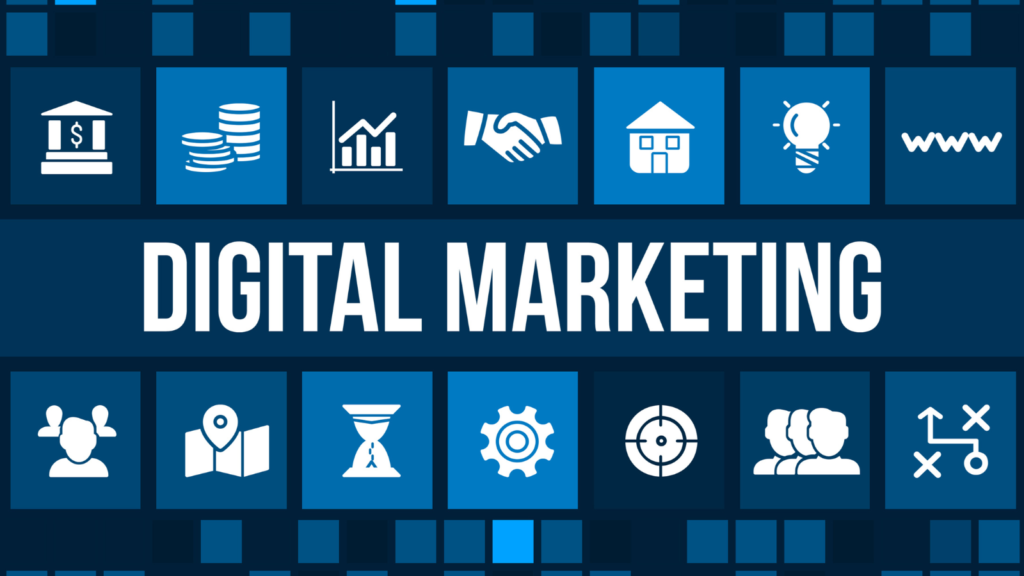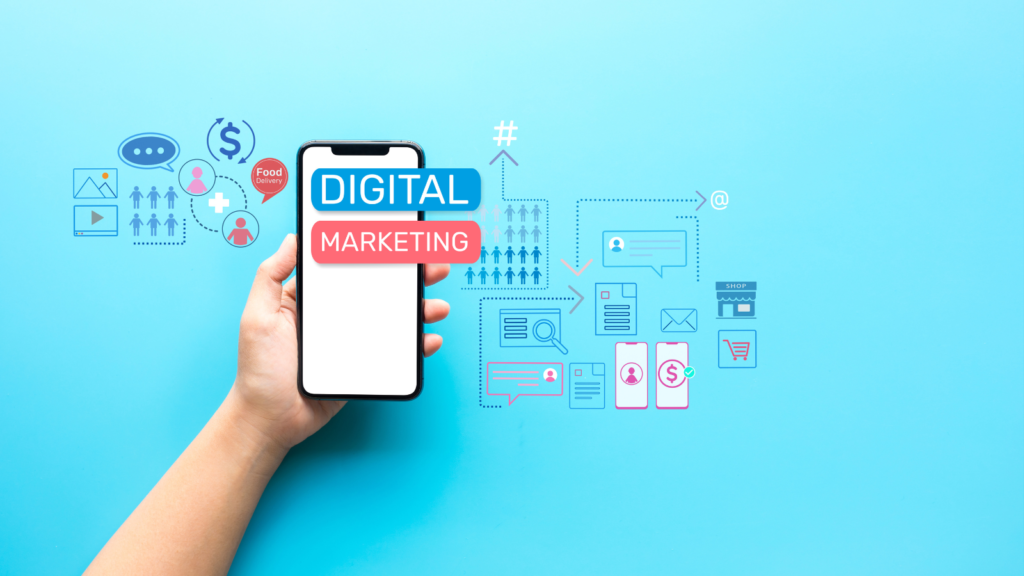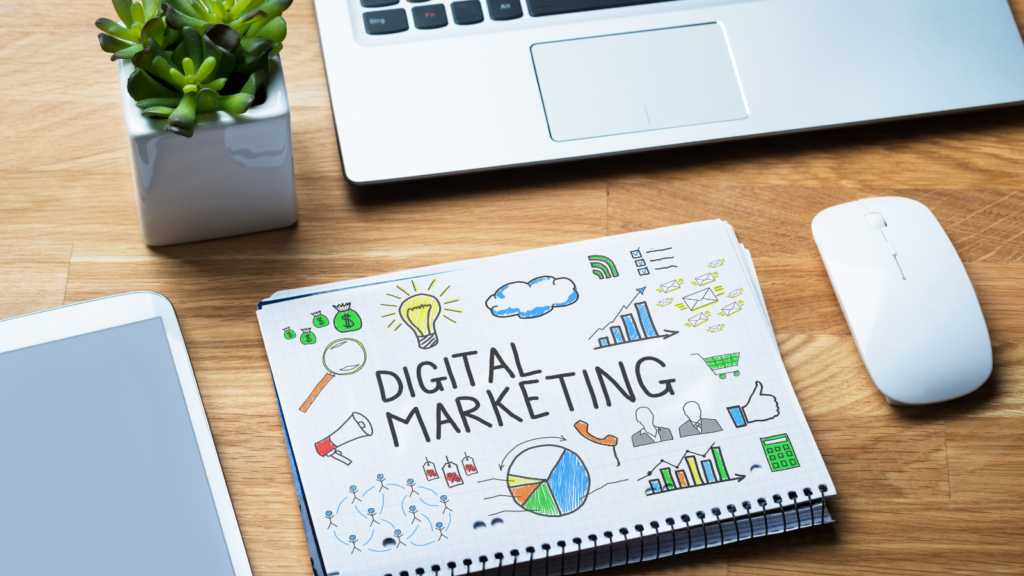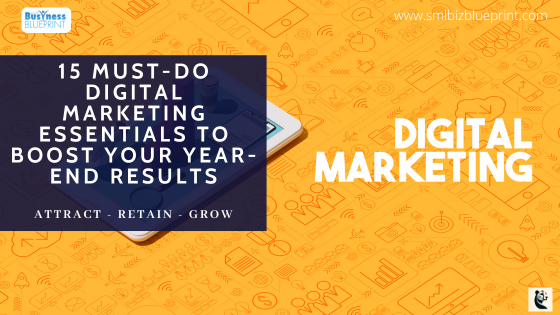As the year comes to a close, there’s no better time to fine-tune your digital marketing strategy.
In these final weeks, a few targeted adjustments can make a significant impact, helping you wrap up the year on a high note while setting a solid foundation for the next.
With consumer behaviour shifting rapidly—especially during the holiday season—staying agile and proactive is essential for any business looking to maximise year-end performance.
This checklist of 15 digital marketing essentials is designed to guide you through critical updates, from audience segmentation to mobile optimisation and advanced AI-driven personalization.
Whether your goal is to boost holiday sales, increase engagement, or simply ensure your strategy is ready for the new year, these actionable tips will empower you to finish strong and start the new year ahead of the curve.

#1 Review and Refresh Your Audience Segmentation
Audience segmentation is foundational to a successful marketing strategy. It allows you to tailor messages to resonate with specific customer groups.
Year-end is an ideal time to revisit and refine your audience segments, especially after the shifts in consumer behaviour throughout the year.
Why It Matters
Audience preferences and behaviours evolve over time. Updating your segmentation ensures you’re delivering relevant content to each group, increasing the likelihood of engagement and conversion.
When done effectively, segmentation helps you allocate resources more efficiently by focusing on high-impact groups.
Tips
- Analyse Recent Data: Review engagement metrics from email campaigns, social media, and website analytics to identify any emerging audience trends.
- Update Buyer Personas: Based on this data, adjust your buyer personas to reflect changes in preferences, purchasing habits, or demographic shifts. Tools like HubSpot and Customer.io can streamline this process.
- Re-segment Your Email Lists: Organize your email lists based on updated segments, such as recent purchasers, high-spending customers, or those who have engaged with holiday promotions.
AI/Automation Integration
Consider using AI-driven tools like Dynamic Yield or Segment to create highly personalised campaigns. These platforms use machine learning to predict audience behaviours and dynamically adjust content based on each user’s profile, automating personalisation at scale.
#2 Prioritize Mobile Optimization for a Seamless User Experience
With the majority of consumers accessing content through mobile devices, mobile optimisation is no longer optional—it’s a necessity.
Ensuring your site is mobile-friendly as the year-end rush approaches can significantly enhance user engagement, boost search rankings, and increase conversions.
Why It Matters
Mobile users expect fast, intuitive browsing experiences. A poorly optimised mobile site can lead to higher bounce rates, lower engagement, and lost sales opportunities. Google also prioritises mobile-friendly sites in search rankings, making this optimisation essential for visibility.
Tips
- Run Mobile Performance Tests: Use Google’s Mobile-Friendly Test and PageSpeed Insights to assess your site’s mobile usability and load speed. These tools can highlight issues with navigation, font size, and loading times.
- Optimize for Speed: Reduce image file sizes and leverage browser caching. Consider using a Content Delivery Network (CDN) to distribute content more quickly to global users.
- Streamline Navigation: Make sure mobile navigation is intuitive with easily clickable buttons, visible CTAs, and simple menus. Avoid overcrowded layouts that can overwhelm mobile users.
AI/Automation Integration
Platforms like NitroPack offer automated solutions for mobile performance optimisation. They adjust elements in real-time to ensure peak loading speeds and a seamless experience across devices.
#3 Speed Up Your Website for Better Engagement and Rankings
Website speed is a critical factor in user experience and SEO. A fast-loading site not only keeps visitors engaged but also signals to search engines that it is optimised and user-friendly. As you approach year-end, take time to address any performance issues that could impact your site’s speed.
Why It Matters
Research shows visitors are likelier to abandon a page that takes longer than three seconds to load. Slow speeds can hurt conversions, lead to higher bounce rates, and negatively impact SEO rankings. Improving load times can have an immediate positive effect on engagement and retention.
Tips
- Run a Speed Audit: Use tools like GTmetrix and Google PageSpeed Insights to identify speed issues on your website. These tools offer insights into specific factors, like image size and server response times, that could slow down your site.
- Optimise Images and Videos: Large media files are common culprits in slow loading times. Use compression tools like TinyPNG for images and HandBrake for videos to reduce file sizes without losing quality.
- Leverage Browser Caching and Minify Resources: Enable browser caching to store frequently accessed resources locally for users, which reduces load times on subsequent visits. Minify CSS, JavaScript, and HTML files to eliminate unnecessary code and improve speed.
AI/Automation Integration
Consider using an AI-driven tool like NitroPack or Cloudflare for automated website performance enhancements. These platforms can dynamically adjust content delivery and optimise loading speeds in real time.

#4 Conduct a Year-End Content Audit
A content audit is a powerful way to assess your marketing strategy’s effectiveness and areas for improvement. By analysing your existing content, you can identify high-performing pieces to promote, update outdated information, and repurpose content to maximise reach and engagement.
Why It Matters
Regular content audits ensure that your content remains relevant and effective. By optimising top-performing posts, updating outdated information, and removing low-performing content, you enhance your brand’s credibility and improve SEO performance.
Fresh, relevant content also keeps your audience engaged and drives more traffic.
Tips
- Identify Top-Performing Content: Use tools like Google Analytics and SEMrush to find which content drives the most traffic, conversions, or engagement. Focus on these high-performing pieces for further promotion and optimisation.
- Update Outdated Information: Review content older than a year and refresh it with current data, updated examples, or new insights. This can boost its performance and relevance, especially if it’s evergreen content.
- Repurpose Content: Turn well-received blog posts into infographics, videos, or social media posts. This allows you to extend the lifespan and reach of your best content, appealing to audiences across various platforms.
AI/Automation Integration
Consider using AI-powered tools like MarketMuse or Frase to analyse content gaps and identify topics or keywords that can further enhance existing posts. These platforms can also suggest updates based on current trends, making keeping your content fresh and relevant easier.
#5 Enhance SEO with Targeted Keyword Updates
SEO is the backbone of digital visibility, and year-end is an ideal time to refine your keyword strategy. Updating your targeted keywords based on recent trends and search behaviour ensures that your content remains relevant, ranks higher, and attracts more organic traffic.
Why It Matters
Search trends change frequently, and what worked at the beginning of the year may not be as effective now. Updating your keywords aligns your content with current search intent, helping you capture more traffic and improving your competitive edge in search rankings.
Tips
- Perform a Keyword Audit: Use tools like Ahrefs or SEMrush to review your existing keywords and identify any that are underperforming or have lost relevance. Look for new keywords that reflect recent industry trends or seasonal interest.
- Integrate Long-Tail Keywords: Long-tail keywords are more specific and often have less competition, making it easier to rank. Focus on phrases that align with user intent, such as “best digital marketing tools for small businesses” or “how to optimise content for SEO in 2024.”
- Update Meta Tags and Headers: Revise meta descriptions, titles, and headers for existing content to incorporate your updated keywords. This small change can enhance your click-through rate (CTR) and improve search engine rankings.
AI/Automation Integration
Consider using AI-driven tools like Clearscope or Surfer SEO to streamline your keyword research. These tools analyse top-performing pages and suggest keywords, headings, and related terms to enhance content relevancy and boost rankings.
#6 Double-Check Your Ad Budget and Campaign Performance
As the year wraps up, reviewing your ad spend and campaign performance can help you make necessary adjustments for maximum ROI. By analysing what’s worked and what hasn’t, you can reallocate the budget to high-performing campaigns, cut underperforming ads, and set clear priorities for next year.
Why It Matters
Digital ad costs often fluctuate during the holiday season, and an unchecked budget can quickly spiral. Regular monitoring ensures you’re spending wisely, maximising conversions, and maintaining profitability.
This review can also reveal patterns and insights for setting an efficient budget in the coming year.
Tips
- Audit Campaign Performance: Use platforms like Google Ads and Facebook Ads Manager to review key performance metrics—CTR, CPC, conversion rate, and ROI—for each campaign. Identify campaigns delivering high returns and allocate additional budget as needed.
- Pause Low-Performing Ads: Identify underperforming ads consuming budget without driving results. Pausing these ads can free up budget for high-performing campaigns, allowing you to focus on quality over quantity.
- Set Up Automated Alerts: Many ad platforms allow you to set up alerts for overspending or performance drops. Enable these alerts to monitor budget allocation without manual checks, helping you stay on top of any sudden fluctuations.
AI/Automation Integration
Consider using AI tools like Adzooma or Optmyzr for automated ad optimisation. These platforms use machine learning to analyse ad performance and suggest adjustments to maximise results while minimising ad spend.
#7 Maximize Email Marketing Campaigns for the Holidays
Holiday seasons present a significant opportunity to boost sales through email marketing.
With people actively shopping, planning, and engaging with brands, a well-executed email marketing strategy can drive conversions and keep your brand top of mind. Maximising your holiday email campaigns can capture interest, encourage repeat purchases, and strengthen customer loyalty.
Why It Matters
Email marketing consistently delivers one of the highest returns on investment (ROI) among digital channels. During the holidays, customers are primed to open promotional emails and act on limited-time offers, making email a valuable tool for end-of-year success.
Tips
- Segment Your Audience for Relevance: Create specific audience segments for tailored messaging—new customers, repeat buyers, holiday shoppers, and lapsed customers. By sending relevant content, you improve open rates and engagement.
- Create Urgency with Limited-Time Offers: Design campaigns around exclusive, time-sensitive promotions to encourage quick action. Use subject lines like “Last Chance: Holiday Sale Ends Soon” to boost open rates and drive urgency.
- Automate Follow-Up Sequences: Set up automated follow-up emails for cart abandonments, holiday reminders, or special offers. This helps you stay in touch with potential buyers without constant manual effort.
AI/Automation Integration
Use AI-powered tools like Klaviyo or SendinBlue to optimize your email campaigns. These platforms offer AI-driven personalisation, recommending products based on previous purchases and predicting the best times to send emails for higher open rates.

#8 Ensure Strong Call-to-Actions (CTAs) Across All Content
A well-crafted call-to-action (CTA) can make the difference between a passive visitor and a converted customer.
Review and optimise CTAs across your content as you approach year-end to ensure they’re clear, persuasive, and strategically placed to drive action, especially during the high-conversion holiday period.
Why It Matters
CTAs guide your audience toward taking the next step, whether making a purchase, subscribing, or downloading content. Effective CTAs help to reduce friction and create a clear path for users, boosting conversion rates and maximising the impact of your campaigns.
Tips
- Review and Refine CTA Copy: Use actionable, direct language that motivates readers. Phrases like “Shop the Holiday Collection” or “Claim Your Year-End Discount” are specific and relevant to the season.
- Test CTA Placement: Experiment with placing CTAs in various locations, such as at the beginning, middle, and end of your content, to see what performs best. Placing CTAs after a value-driven section often increases the likelihood of action.
- Incorporate Visual Cues: Use buttons, contrasting colours, and directional arrows to make CTAs stand out. This draws attention to the CTA and improves click-through rates.
AI/Automation Integration
Use tools like Unbounce or Optimizely for A/B testing your CTAs. These platforms can analyse user behaviour and automatically suggest CTA adjustments based on what performs best, helping you maximise conversions with minimal effort.
#9 Leverage Retargeting Ads for Higher Conversions
Retargeting ads are an effective way to re-engage potential customers who have interacted with your brand but haven’t yet converted.
Retargeting campaigns can help you reach these high-intent audiences and boost conversion rates with year-end sales and holiday shopping in full swing.
Why It Matters
Retargeting helps recapture interest from people familiar with your brand, making them more likely to convert. These ads keep your brand top of mind, encourage repeat visits, and often lead to higher ROI compared to standard display ads.
Tips
- Set Up Retargeting Audiences: Use platforms like Google Ads and Facebook Ads to create segmented retargeting audiences based on actions such as website visits, abandoned carts, or product views. This ensures your ads reach those most likely to convert.
- Create Personalized Ad Copy and Visuals: Tailor your retargeting ads to each audience segment. For example, show abandoned cart users the exact products they left behind with a reminder or discount, which can nudge them toward completing their purchase.
- Offer Exclusive Deals or Free Shipping: Incentivize returning visitors with special offers, discounts, or free shipping. This added incentive can make the decision to purchase easier and more appealing.
AI/Automation Integration
Consider using AI-powered platforms like AdRoll or Criteo to automate retargeting efforts. These tools use machine learning to optimise audience targeting, personalise ad content, and adjust bids to improve your retargeting ROI.
#10 Fine-Tune Your Social Media Strategy for Peak Engagement
Social media plays a crucial role in year-end marketing, and refining your strategy can boost engagement, brand awareness, and conversions.
With increased activity on social channels during the holiday season, a well-planned social media approach can help you reach your audience effectively and make the most of this high-engagement period.
Why It Matters
Social media engagement often spikes around the holidays as users search for gifts, deals, and seasonal inspiration. A targeted strategy can capture this heightened interest, driving more traffic to your website and increasing opportunities for conversion.
Tips
- Plan Seasonal Content: Create content tailored to the season, such as gift guides, holiday promotions, and countdowns. Use visually appealing posts and stories that capture the holiday spirit to stand out in crowded feeds.
- Optimise Posting Times: Review your social media analytics to identify when your audience is most active. Posting during peak times can improve reach and engagement, ensuring your content is seen by more users.
- Engage Directly with Followers: Increase interaction by responding to comments, liking follower posts, and encouraging user-generated content with holiday hashtags. This builds a sense of community and loyalty while expanding your brand’s reach.
AI/Automation Integration
Use social media management tools like Hootsuite or Sprout Social to automate posting schedules and monitor engagement. AI-powered features on these platforms can analyse engagement patterns and suggest optimal posting times to maximise reach and engagement.
#11 Add AI-Driven Personalization to Your Marketing Mix
Personalisation is no longer a “nice-to-have” but a necessity, especially as consumers expect brands to understand and cater to their preferences.
Incorporating AI-driven personalisation into your marketing mix can help you deliver highly relevant content and offers, enhancing engagement, customer satisfaction, and conversions.
Why It Matters
Personalised experiences strengthen customer connections and improve engagement.
AI-driven personalisation allows you to automate and scale these efforts, using data insights to anticipate customer needs and deliver timely, relevant messages that increase the likelihood of conversion.
Tips
- Implement Dynamic Product Recommendations: Use AI tools like Dynamic Yield or Amazon Personalize to display personalised product recommendations on your website or in emails based on each customer’s past behaviour and preferences.
- Create Personalized Email Campaigns: Use customer data to segment audiences and send targeted email campaigns with unique offers, content, or product suggestions. Platforms like Klaviyo and Mailchimp offer AI-powered personalisation features to tailor content for each recipient.
- Optimise Landing Pages for Different Audiences: AI tools like Optimizely can dynamically adjust landing page elements based on visitor profiles, helping you provide a tailored experience that resonates with individual users and increases conversions.
AI/Automation Integration
Leverage machine learning tools to gather insights on customer behaviour and automate personalised recommendations.
Platforms like Segment or Adobe Target can aggregate data from various sources to create real-time profiles, ensuring a seamless and customised experience across all touchpoints.

#12 Update and Optimize Local SEO Listings
For businesses with a physical presence or local service area, maintaining accurate and optimised local SEO listings is essential to attract nearby customers.
As the year-end approaches, it’s a good time to review your listings, ensuring they’re up-to-date and fully optimised to capture local search traffic during the busy holiday period.
Why It Matters
Local SEO listings, such as Google Business Profile, play a significant role in helping potential customers find you.
Accurate listings improve your visibility in local searches and drive more foot traffic or local inquiries. This is especially valuable during the holiday shopping season when consumers are looking for quick, nearby options.
Tips
- Claim and Verify All Listings: Make sure you have claimed your business on platforms like Google Business Profile, Yelp, and Bing Places. Verification helps establish credibility and ensures you can manage your information.
- Update Key Information: Check that all details—address, phone number, website URL, and business hours—are current and correct. If you have extended holiday hours, ensure they are reflected in your listings to avoid confusion.
- Encourage Customer Reviews: Positive reviews boost your local ranking and build trust. Encourage satisfied customers to leave reviews and respond to any feedback to demonstrate active engagement with your audience.
AI/Automation Integration
Use tools like BrightLocal or Moz Local to manage and update your listings across multiple platforms. These tools can automate listing updates, monitor reviews, and alert you to inconsistencies or errors, ensuring your local SEO remains accurate and effective.
#13 Use A/B Testing to Optimize Key Landing Pages
Landing pages are critical for conversions, and the end of the year is an ideal time to refine them for maximum impact.
A/B testing different elements of your landing pages—such as headlines, CTAs, and images—can reveal which combinations resonate best with your audience, allowing you to drive higher engagement and conversions during the high-traffic holiday season.
Why It Matters
Optimising landing pages through A/B testing helps you make data-driven improvements, boosting conversion rates and overall campaign performance. Small adjustments to key elements can significantly impact user behaviour and decision-making, providing insights that can inform future campaigns.
Tips
- Identify High-Impact Pages for Testing: Prioritize landing pages that drive significant traffic or serve as entry points to critical campaigns, such as product pages or holiday offers. Testing these pages can yield the greatest return on investment.
- Test One Element at a Time: Start by testing a single element, like the headline, CTA, or hero image, to isolate its impact on user engagement. Once you gather insights, move on to testing another element for a clear understanding of what works best.
- Analyse and Implement Results: After collecting data, analyse the results to determine which variations perform best. Implement the winning elements and consider running additional tests for further refinement.
AI/Automation Integration
Use AI-powered A/B testing tools like Google Optimize or VWO to streamline the process. These platforms can automatically serve the best-performing variants to visitors, making real-time adjustments to maximise conversions and optimise user experience.
#14 Set Up or Adjust Automation Workflows for Efficiency
Automation workflows can streamline repetitive tasks, reduce manual work, and ensure your audience receives timely, relevant communication.
As the year comes to a close, revisiting or setting up automation workflows can save time and improve efficiency for your year-end campaigns and beyond.
Why It Matters
Automation allows you to maintain consistent engagement with your audience, nurture leads, and maximise conversions with minimal hands-on effort. Well-designed workflows can automatically respond to customer actions, ensuring every opportunity is noticed, especially during the busy holiday season.
Tips
- Identify Key Workflows: Focus on essential workflows that align with your end-of-year goals, such as welcome sequences, abandoned cart reminders, post-purchase follow-ups, and seasonal promotions. These workflows keep your audience engaged without requiring manual intervention.
- Personalize Messages Within Each Workflow: Use customer data to tailor the messages within your workflows. For example, an abandoned cart email could highlight the specific items left behind, adding a personalised touch to increase the likelihood of conversion.
- Monitor Performance and Adjust as Needed: Review workflow analytics to see how each sequence performs. Identify workflows with low engagement or high drop-off rates and adjust the timing, message, or offers to improve results.
AI/Automation Integration
Consider using tools like ActiveCampaign, HubSpot, or Marketo to set up and manage workflows. These platforms offer AI-driven features that can recommend optimal send times, personalise content, and provide insights into which workflows are driving the best results.
#15 Review and Refine Your Analytics for Clearer Insights
Effective digital marketing is data-driven, and reviewing your analytics setup before year-end ensures you’re equipped with accurate insights to guide next year’s strategy.
By refining your analytics, you can track performance more accurately, measure ROI, and make informed decisions that align with your business goals.
Why It Matters
Clear, actionable data is essential for understanding what’s working and where there’s room for improvement. With accurate tracking and insightful reports, you can identify high-performing campaigns, discover areas needing adjustment, and prepare for data-driven marketing efforts in the new year.
Tips
- Verify Your Tracking Codes: Double-check that tracking codes (e.g., Google Analytics, Facebook Pixel) are correctly implemented on key pages. Misplaced or missing tags can result in incomplete data, leading to inaccurate insights.
- Set Up Goal Tracking and Conversions: Define specific goals, such as purchases, sign-ups, or downloads, and track them through your analytics platform. Conversion tracking helps you understand which campaigns are driving results and optimize accordingly.
- Generate Custom Reports for End-of-Year Review: Create reports focusing on the metrics most relevant to your business objectives, such as customer acquisition cost (CAC), return on ad spend (ROAS), and customer lifetime value (CLV).
These insights can provide a comprehensive overview of your digital marketing performance.
AI/Automation Integration
Platforms like Google Analytics 4 and Adobe Analytics use machine learning to provide predictive insights, such as forecasting trends and identifying patterns in user behaviour.
These tools can help automate reporting and highlight key insights, making refining your strategy based on real data easier.
Conclusion
As the year wraps up, these 15 digital marketing essentials provide a structured approach to optimising your strategy, maximising conversions, and setting your business up for success.
From refreshing audience segmentation and fine-tuning CTAs to leveraging AI-driven personalisation and enhancing local SEO, these steps bring you closer to achieving your year-end goals and starting the new year with a strong foundation.
Whether you’re boosting holiday sales, refining your ad budget, or implementing automation workflows, each tip is designed to help you make impactful improvements.
By reviewing, optimising, and adjusting, you’ll be well-positioned to meet your audience’s needs, strengthen your brand, and grow your results.
Ready to start implementing these essentials?
Begin with the areas that promise the highest return, and build momentum as you go.
Subscribe to our blog for more insights, resources, and tips on the latest digital marketing trends.
Let’s make this year-end your most successful yet!
FAQs
Q1: Why is it important to review my digital marketing strategy before the end of the year?
A1: Year-end reviews help you assess what’s working and identify areas for improvement. By refining your strategy now, you can boost holiday performance, optimise your budget, and set a strong foundation for the upcoming year.
Q2: How can I improve my website’s loading speed?
A2: Improving website speed involves steps like compressing images, leveraging browser caching, and using a Content Delivery Network (CDN). Tools like Google PageSpeed Insights and GTmetrix can help you identify speed issues and provide actionable suggestions.
Q3: What’s the best way to set up automation workflows for my campaigns?
A3: Start by identifying key workflows that align with your business goals, such as welcome sequences, abandoned cart reminders, and post-purchase follow-ups. Platforms like HubSpot and ActiveCampaign make it easy to automate these workflows, helping you stay connected with your audience while saving time.
Q4: How can A/B testing help improve my marketing campaigns?
A4: A/B testing allows you to experiment with different versions of your landing pages, ads, and emails to see which performs best. By testing one element at a time, you can make data-driven improvements that increase engagement and conversions. Tools like Google Optimize and VWO can assist with running A/B tests.
Q5: Why is mobile optimisation essential for my website?
A5: More consumers are browsing and shopping on mobile devices than ever before. Mobile optimisation ensures a smooth, user-friendly experience, which can reduce bounce rates, improve engagement, and boost search rankings. Testing with Google’s Mobile-Friendly Test tool can help ensure your site is optimised for mobile.
Q6: How does AI-driven personalisation benefit my digital marketing?
A6: AI-driven personalisation enables you to tailor content, product recommendations, and emails based on individual user behaviour. This level of personalisation enhances engagement, builds loyalty, and increases conversion rates. AI tools like Dynamic Yield and Klaviyo can help you integrate personalisation into your strategy.
Q7: What is the role of local SEO, and how can I optimise my local listings?
A7: Local SEO helps businesses with a physical presence or service area attract nearby customers. Optimising local listings involves updating accurate information, encouraging reviews, and regularly monitoring platforms like Google Business Profile. This enhances your visibility in local searches, driving more foot traffic or inquiries.
Other Articles
Using Benchmarking to Improve Small Business Performance
How To Make Predictive Analysis Worthwhile For Your Small Business




